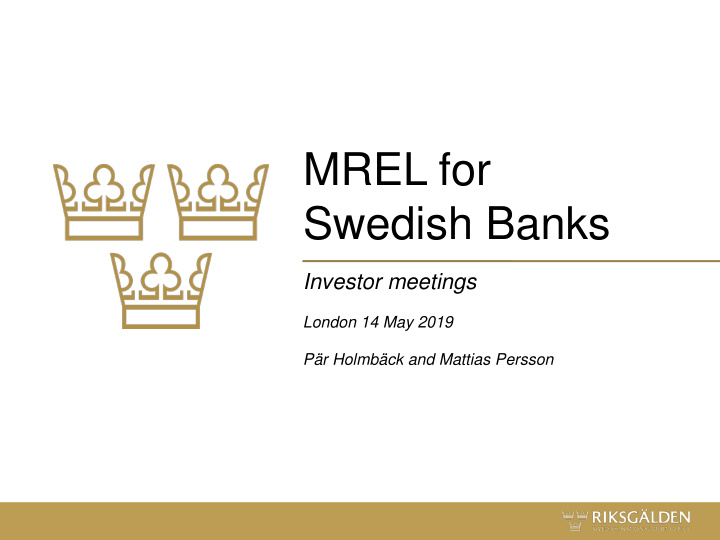



MREL for Swedish Banks Investor meetings London 14 May 2019 Pär Holmbäck and Mattias Persson
Riksgälden’s current MREL policy Institutions are bound by the de facto Liabilities proportion principle* requierment* 35% Total: 30.7% Institution SEK billion 30% Handelsbanken 25% RA = 86 11.9% Total: 21.6% LPP Total: 18.8% 20% SEB 87 11.9% 6.9% CBR 15% RA Swedbank 73 10% P2 Capital 3.9% 18.8% req. Other 41 5% 9.7% LAA 8% P1 0% Total 287 Capital reqirement MREL requirement De facto requirement *Average requirements for the three largest Swedish banks. *Based on capital requirements as of Q4 2018. Possible maturity and Data as of Q4 2018. management buffers not accounted for. Riksgälden’s current calibration formula: The Liabilities proportion principle (LPP) mandates that institutions hold an amount equal to the recapitalization MREL = + amount in subordinated debt instruments. 𝑄1 + 𝑄2𝑆 − 𝑄2𝑛𝑏𝑑𝑠𝑝 𝑄1 + 𝑄2𝑆 This ensures a separation of going and gone concern resources, and that capital buffers may be used as intended Loss absorption Recapitalization amount amount
Sweden’s framework allows for statutory subordination Aim of Indicative • Legislation specifying insolvency priority in subordination Balance sheet place since 1 st of January 2019 Increase • This allows for issuance of senior non- Other debt resolvability preferred (SNP) instruments with statutory Achieve clarity subordination for investors Bail-inable debt (pricing and (senior unsecured • Contractual and structural subordination etc.) risk) Additional (e.g. senior instruments issued from a LAC Subordinated debt Mitigate ~5% HoldCo) allowed, but not foreseen in of assets NCWO- Hybrid capital practice concerns LAC* CET 1 ~3% of assets • Swedbank and SEB received rating uplifts (Moody’s) for senior unsecured debt in April 2018 due to expectation of increased additional loss absorbing debt* Parent Losses • Internal (subordinated) MREL-requirements Sub 1 Sub 2 allow for upstreaming of losses to the Losses resolution (parent) entity Sub 3 *Loss absorbing capacity. Moody’s account for loss absorbing debt * Moody's takes rating actions on four large Swedish banks due to MREL requirements, Moody’s Investors Service, 2018-04-20 within its loss given failure framework while S&P uses the term ALAC.
BRRD2 finalized on EU-level BRRD1 Swedish LoR BRRD2 [Swedish LoR2] 2014 2015 2016 2017 2018 2019 2020 2021 2022 2023 2024 2025 FSB Key FSB TLAC Riksgälden BRRD2 final deadline deadline attributes TS • BRRD2 introduces additions and changes to the current directive, mainly regarding MREL • The calibration (including internal MREL) will be set in law to a higher degree • Mandatory subordination is introduced • Possibility of M-MDA restrictions implies that capital buffer requirements are added on top of the MREL-requirement • Additional measures to deal with breaches of the MREL-requirement are also introduced • The transposition in Sweden is subject to a public inquiry. Specific changes to the current MREL-policy is not yet known. Riksgälden has however communicated the following: The current MREL-policy is largely compatible with BRRD2 It is essential that banks begin their issuances of subordinated debt instruments. The banks shall act with the intention to achieve the target levels by 1 st of January 2022.
MREL instrument considerations Maturity Callability • • Maturities of 5 years or longer are foreseen European banks have started to issue callable SNP- bonds although some legal uncertainty remain under • Refinancing risks are a function of funding mix, including current legal framework maturity, as well as the level of the MREL-requirement • BNP Paribas was first (early 2019) to issue EUR- • M-MDA article in BRRD2 stipulates that current market denominated callable SNP-bond environment shall be taken into account before deciding • on any measures to limit dividend payments Riksgälden has not communicated any position on callability • Refinancing risks are a matter for the SFSA under going • concern Clarification is expected through BRRD2 and EBA RTS Subordination levels FX-mix • Riksgälden’s general conclusion is that the current • SEB, Swedbank and Handelsbanken are likely to issue MREL-policy is largely compatible with the new large parts of their subordinated debt requirements in legislative framework EUR and USD • The prudential formula for subordination, • Smaller Swedish systemic banks are likely to issue 2*(P1+P2)+CBR is equal to the current de facto requirements for Swedish banks larger parts in SEK • BRRD2 introduces the possibility for senior allowance • The current senior unsecured SEK-denominated market • Riksgälden’s general view is that subordination is of high is limited in size, but may increase in subordinated importance to ensure investors certainty, and to mitigate space due to higher yields? NCWO concerns. The subordination requirement was thus set at 100% for the current MREL-policy.
The global TLAC/MREL market has been established G-SIB issuance* m USD 80,000 60.00% 70,000 50.00% 60,000 40.00% 50,000 40,000 30.00% 30,000 20.00% 20,000 10.00% 10,000 0 0.00% Own funds SNP Senior unsecured Share SNP (right axis) *Own funds data missing for March and April 2019. Source: Riksgälden based on Bloomberg. The activity in 2019 has generally been good, and the supply is well absorbed by the market Riksgälden is monitoring developments and is in a continuous dialogue with the banks
Recommend
More recommend